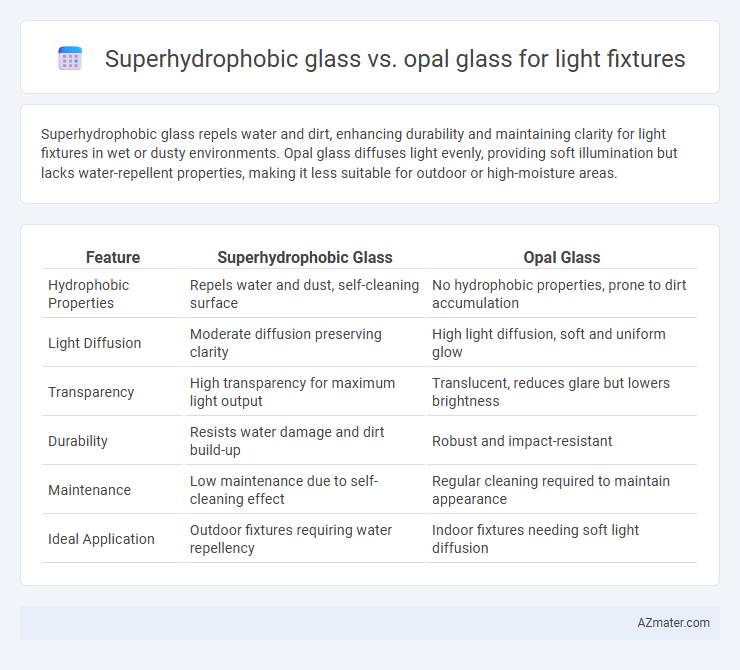Superhydrophobic glass repels water and dirt, enhancing durability and maintaining clarity for light fixtures in wet or dusty environments. Opal glass diffuses light evenly, providing soft illumination but lacks water-repellent properties, making it less suitable for outdoor or high-moisture areas.
Table of Comparison
| Feature | Superhydrophobic Glass | Opal Glass |
|---|---|---|
| Hydrophobic Properties | Repels water and dust, self-cleaning surface | No hydrophobic properties, prone to dirt accumulation |
| Light Diffusion | Moderate diffusion preserving clarity | High light diffusion, soft and uniform glow |
| Transparency | High transparency for maximum light output | Translucent, reduces glare but lowers brightness |
| Durability | Resists water damage and dirt build-up | Robust and impact-resistant |
| Maintenance | Low maintenance due to self-cleaning effect | Regular cleaning required to maintain appearance |
| Ideal Application | Outdoor fixtures requiring water repellency | Indoor fixtures needing soft light diffusion |
Introduction to Glass Types for Light Fixtures
Superhydrophobic glass features an advanced water-repellent coating that enhances durability and maintains clarity by preventing water and dirt accumulation, making it ideal for outdoor light fixtures exposed to harsh weather conditions. Opal glass, characterized by its milky, translucent appearance, diffuses light evenly to reduce glare and create soft, ambient illumination suitable for indoor lighting applications. Choosing between superhydrophobic and opal glass depends on the desired combination of weather resistance and light diffusion properties in light fixture design.
What is Superhydrophobic Glass?
Superhydrophobic glass is a specially coated surface designed to repel water and prevent droplets from sticking, ensuring crystal-clear transparency and reducing the need for frequent cleaning in light fixtures. This advanced glass technology uses nanoscale textures to create an extreme water contact angle, promoting self-cleaning properties and enhanced durability against environmental contaminants. In comparison, opal glass diffuses light for a softer glow but lacks the water-repellent characteristics critical for outdoor or moisture-prone lighting applications.
What is Opal Glass?
Opal glass is a type of translucent glass made by adding opacifying agents like tin oxide or bone ash to create a milky, diffused appearance, ideal for evenly distributing light in fixtures. This glass reduces glare and softens illumination, enhancing ambient lighting quality without harsh shadows. Compared to superhydrophobic glass, which repels water and reduces dirt buildup, opal glass prioritizes light diffusion and aesthetic appeal in lighting design.
Optical Properties: Transparency and Diffusion
Superhydrophobic glass offers superior transparency with minimal light scattering, ensuring maximum clarity and brightness in light fixtures. Opal glass provides excellent light diffusion, creating a soft, uniform glow that reduces glare but slightly diminishes overall transparency. Choosing between the two depends on whether the priority is clear, bright illumination or gentle, evenly distributed light.
Durability and Maintenance Comparison
Superhydrophobic glass offers superior durability with its water-repellent coating that resists dirt, stains, and corrosion, reducing the need for frequent cleaning in light fixtures. Opal glass, while providing diffused light, tends to accumulate dust and grime more easily, requiring regular maintenance to preserve clarity and appearance. The robust, self-cleaning properties of superhydrophobic glass result in longer-lasting performance and lower maintenance costs compared to traditional opal glass.
Light Transmission Efficiency
Superhydrophobic glass demonstrates higher light transmission efficiency compared to opal glass, allowing more natural light to pass through with minimal reflection and scattering. Its water-repellent surface reduces dust and dirt accumulation, maintaining clarity and consistent light output over time. Opal glass, while diffusing light evenly, tends to diffuse and absorb more light, resulting in lower overall transmission efficiency.
Aesthetic Differences in Lighting Applications
Superhydrophobic glass in light fixtures offers a sleek, clear appearance that enhances brightness and clarity by minimizing water and dust accumulation, maintaining consistent light diffusion. Opal glass provides a soft, frosted aesthetic that diffuses light evenly, creating a warm, ambient glow ideal for cozy or decorative lighting environments. The choice between superhydrophobic and opal glass significantly impacts the fixture's visual appeal, with superhydrophobic glass emphasizing transparency and modernity, while opal glass emphasizes softness and warmth.
Cost and Availability Analysis
Superhydrophobic glass typically incurs higher costs due to advanced nanocoating technologies required to achieve water-repellent and self-cleaning properties, limiting its widespread availability primarily to specialized suppliers. Opal glass, known for its diffused light effect and lower production expenses, is more readily available through standard glass manufacturers and constitutes a cost-effective option for mass-market light fixtures. Evaluating total project budgets, opal glass presents a budget-friendly and accessible material choice, whereas superhydrophobic glass suits premium applications demanding enhanced durability and maintenance reduction.
Ideal Use Cases for Superhydrophobic and Opal Glass
Superhydrophobic glass is ideal for outdoor light fixtures exposed to rain, dust, and dirt due to its water-repellent and self-cleaning properties, ensuring clear light transmission and reduced maintenance. Opal glass excels in indoor lighting environments where diffuse, soft illumination is desired, effectively minimizing glare and creating uniform light diffusion. Choosing superhydrophobic glass suits harsh weather conditions, while opal glass is preferable for aesthetic indoor applications requiring gentle, even light distribution.
Choosing the Best Glass for Your Lighting Needs
Superhydrophobic glass offers superior water and dust repellency, making it ideal for outdoor light fixtures exposed to harsh weather conditions, ensuring long-lasting clarity and minimal maintenance. Opal glass provides a soft, diffused light effect that reduces glare and creates a warm ambiance, perfect for indoor lighting applications prioritizing aesthetics and comfort. When choosing the best glass for your lighting needs, consider the environment and desired light quality, opting for superhydrophobic glass in challenging outdoor settings and opal glass for decorative indoor use.

Infographic: Superhydrophobic glass vs Opal glass for Light fixture
 azmater.com
azmater.com